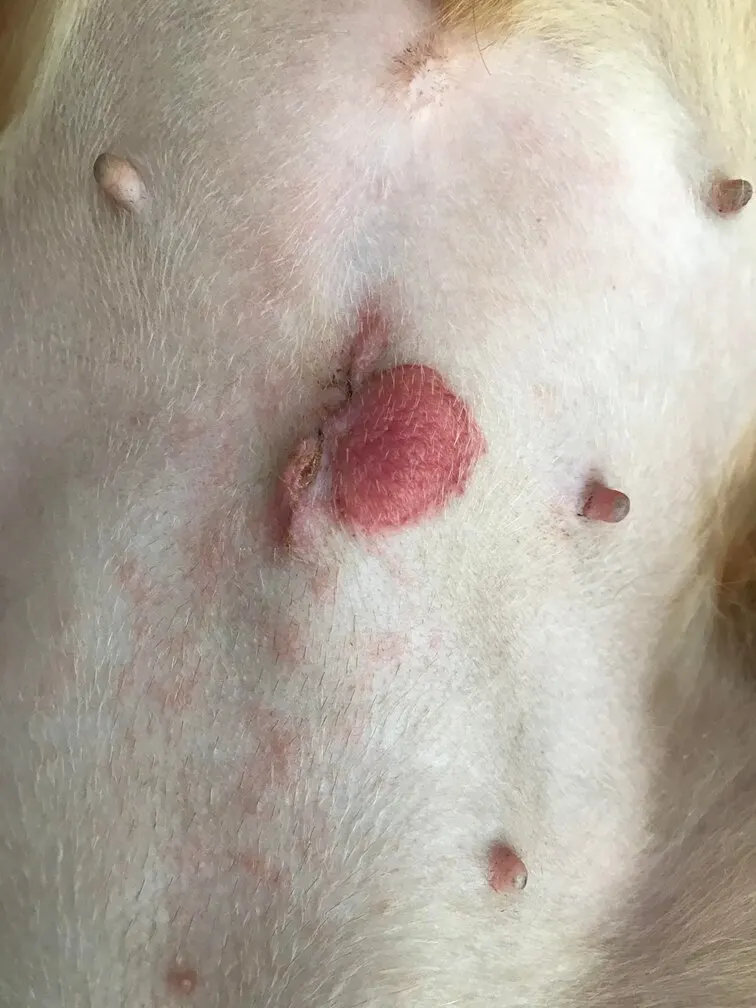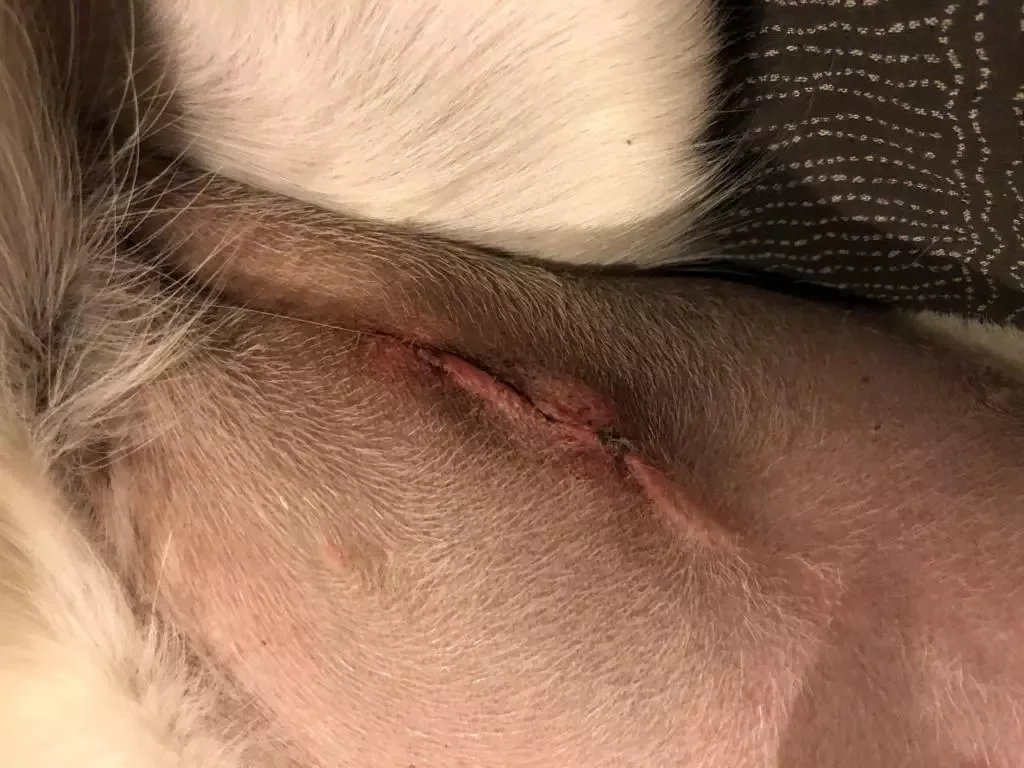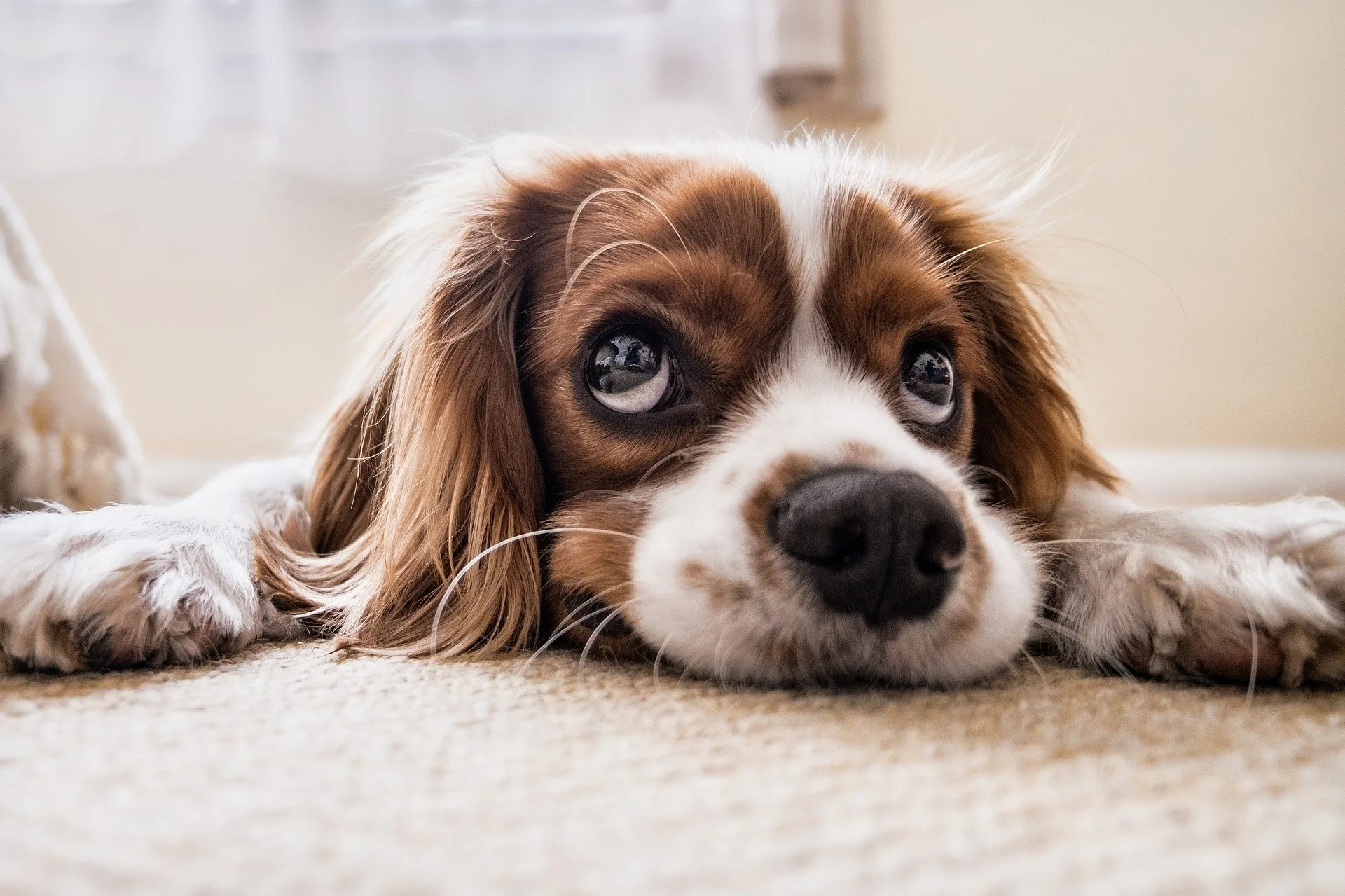Having your dog spayed or neutered is a stressful experience, not only for your canine but for you too. However, finding a lump on the cut after spaying is even more stressful.
But, don’t panic.
The dog spay incision lump you can see and feel on your dog’s stomach is actually a seroma and it’s completely normal.
There are actually many possibilities of what the lump might be. In most cases, seromas aren’t a reason to visit the veterinarian. However, we would always suggest sending your veterinarian a picture of the lumps or taking your dog for a check-up.
No, let’s take a closer look at what that dog spay incision lump actually is.
What is a seroma?
A seroma is a fluid accumulation within a pocket of tissue under the skin. We call that fluid – serum, hence the name seroma.
The most common reasons is tearing of the seams and the cut not being closed properly after the surgery.
Dr. Ivana Crnec, a veterinarian, provides information on seromas in dogs, including their causes, prevention tips, and treatment options. To get a better idea of what seromas in dogs normally look like, you might also find it useful to look at some pictures of seroma.
While seromas aren’t usually dangerous, it’s also very important to confirm that the swelling is actually a seroma and not an infection. That’s why you should always check with your veterinarian and have them take a look at your dog.

Source: Reddit
How to treat seromas?
Even though seromas aren’t painful, your vet will still tell you about treatment options if they are larger in size.
Generally speaking, your vet will let the seroma heal by itself if it is small in size.
You will have to pay close attention to your dog and monitor the seroma. If there are any changes you should let your veterinarian know immediately.
Possible changes in the seroma:
- The seroma seems larger
- Feels hard
- Hot to the touch
- The skin over the seroma is red
- You notice any other change in color
In the case that your dog’s seroma is getting too big, your veterinarian might insert a needle and extract the fluid from the pocket with a syringe.
Treatment options
- Fluid extractions: Using large needl and syringe, vet will try to extract the accumulation of fluid. Although it is not the best option since the body usually starts generating new fluid, it is something vets wil try first since it is not so invasive or painful for the dog.
- Seroma drainage: As said above, if fluid are formed again, then the vet will have to switch to placing a draing and enable constant drainage of the fluid. This way, no accumulations will ocur.
- Antibiotics: When treating an infected seroma, these medications are utilized in addition to other therapies. Yes, seromas can become infected and can turn into an abscess if they do.
- Analgetics: Additionally, they are used in conjunction with one another and when the seroma is painful.
- Corticosteroids: These may be applied to reduce edema and control the local inflammatory response.
- Surgical correction: When all other options have been exhausted, this is the last resort treatment. In cases where the accumulated fluid forms a protective capsule that prohibits its extraction and drainage, surgical treatment of the seroma is indicated.
How seromas can look like?
Seromas, or those bumps you see on your dog’s incision line, can look different:
- Small round bump at the very top of the incision
- Long bump along the incision area
- Balloon-like bump that’s filled with fluid
- Hard, immoveable bump on or around the incision
- Puckered section of skin along the incision line
All of these are actually completely normal and shouldn’t be any threat to your dog’s health. However, there are certain seromas or situations that might be dangerous and that ask for an expert’s help:

- Red, angry, oozing bumps
If you notice that the bumps around your dog’s incision cut are red and if they are oozing a fluid contact your vet immediately. This can happen at any time actually, not only right after the surgery. Even after several months, there might be changes happening to the cut.
If you notice bumps like that it can be a sign of an infection. If your vet suspects an infection, they will probably do a bacterial culture to identify the specific type of bacteria infecting the site. This way your vet will know what is happening and which antibiotic to prescribe.
- Any change
We’ve mentioned above that complications and infections can happen at any moment in the healing process, even after a few months post-surgery. That’s why it’s important to monitor the cut so that you know if anything changes if anything looks different.
Also, pay attention to your dog’s behavior. Are they acting weird, refusing to eat or to drink, are they aggressive, and so on.
We suggest taking pictures of the incision cut for a couple of weeks. Take the pictures under the same conditions, same light, same time of the day, and so on. Only this way will you be able to keep track of any changes that might happen.
Differential diagnosis
Other Possible Diagnoses for a Seroma Seromas are frequently mistaken for a number of other illnesses and formations due to their appearance. Veterinarians refer to the process of eliminating related illnesses and look-alikes as differential diagnosis.
FAQ about a dog spay incision lump
What is a seroma?
Seroma look like swelling on a spay surgery cut. This can occur during the recovery phase after any type of surgical procedure, but it’s especially common after spaying. After your dog has been spayed, the knot appears around the cutting line on your dog’s belly. This lump feels like a balloon filled up with water around the incision site when you touch it gently. It’s fairly common in dogs, but it can also be seen in cats after surgery.
How long does it take for a dog’s seroma to disappear?
As we already discussed: A seroma is a lump filled up with suture material or leftover blood in the place of a surgical sitethat may not have been optimally closed. While they can rarely become infected, the treatment usually includes local drainage or simply healing and dissolution by itself. Most dissolve after a month or two.
Is swelling normal after your dog has been spayed or neutered?
While your dog is healing after the operation, redness, slight swelling and bruising can occur. But if the wound exerts heat, excessive swelling is visible, pus is present or oozing discharge occurs, you should contact your veterinarian immediately. Those could be signs of an infection, so you want to help your pup as soon as possible.
Is it normal to have a knot or hard lump after sewing?
You can feel bumps and lumps under the skin. This is normal and is due to the resolvable seams below the surface. They will disappear over time. Occasionally, a red bump or pust forms along the seam line when a buried stitch works on the surface.
What does a neutered dog cut look like?
What should the cut look like? The cut should normally be clean and the edges should touch each other. The skin should be a normal or slight red color. It is not uncommon for the cut to become a little redder in the first few days when healing begins.
What happens if the dog spay incision lump remains untreated?
A small dog spay incision lump will more often than not dissolve by themselves. Although they remain untreated, they can calcify and form hard nodes. Larger seromas often require aspiration (removal of liquid), which is generally carried out with a needle. But a normal lump that has not been infected will absolutely go away on its own.
Will my dog’s incision lump go away on its own?
The answer to that is probably yes. As long as the swelling does not appear painful when touched and no discharge occurs, seromas usually recede by themselves. Make sure to clean the lump with warm water before an infection takes place.
How long does it take for a dog to recover from castration?
Most skin cuts after spaying and neutering have completely healed within about 10-14 days, which coincides with the time in which seams on your dog’s incision will have to be removed. But for some dogs, it may take a bit longer. If you are a first-time dog owner make sure you get all the instructions you need from your vet.
I saw a belly lump near my dog’s incision. Help!
A small herniation is not dangerous or even painful. This is when part of your dog’s intestines come out of a small opening on his belly. In the case of a spay procedure hernia, these are usually more serious. If you notice nodules on your dog’s abdomen shortly after the operation, this could be part of the body that heals itself and a naturally occurring inflammation takes place. This could mean that your dog still has a long way to go and that you have to follow all the postoperative instructions. Look out if your dog has a normal appetite or not, or if he experiences much thirst.
How do I prevent my dog from jumping after castration?
After castration, it is important that he or she does not jump, as your dog could fall and hurt himself and possibly tear open his seams. Keep your dog on a leash and as calm as possible 10-14 days after the operation and prevent him from licking the strings with a protective collar. For active dogs that love to exercise it may be hard. But pet experts warn that this is a crucial step in the healing process.
Can scar tissue form a hard knot?
What are keloids? If the skin is injured, fibrous tissue forms over the wound, which is called scar tissue, to repair and protect the injury. This is a spot of tissue reaction, and it’s completely normal. In some cases, additional scar tissue grows and forms smooth, hard growths called keloids. Keloids can be much larger than the original wound.
Why does my dog have a knot under his scar?
If the skin is injured, the tissue breaks, which releases a protein called collagen. Collagen builds up where the tissue is damaged and helps to heal and strengthen the wound. New collagen forms for several months and the blood supplyincreases, making the scar sublime and lumpy.
What does a keloid look like?
Keloids are sublime and look shiny and dome-shaped and range from pink to red. Some keloids become quite large and unsightly. In addition to causing potential cosmetic problems, these exuberant scars tend to be itchy, sensitive or even painful.
How long does wound healing take?
An average incision usually takes 10-14 days to heal completely. This means that as a pet owner you must remain disciplined and wear your pet’s protective collar while restricting its activity for at least 2 weeks after the operation.
How do you know if you tore the inner seams after spraying?
If an inner seam layer breaks, you may notice a new bump under healthy normal skin or sensitivity in this area. If the outer incision gets torn out, the incision is open. This can, unfortunately, cause fat, muscles and even internal organs to fall out of their normal position.
How do you carry a dog after castration?
Put your pet in a sufficiently large transport box, kennel, box or small room if you cannot supervise it. The animal must be able to get up in the stable unit and turn around. If your pet is small, carry it up and down the stairs. Keep your pet on a leash so that it can urinate or empty.
Ensure the dog stays in a quiet place and use Elizabethan collar to prevent him from licking wounds.

